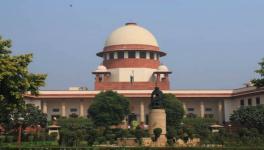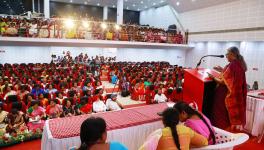Cyclone Fani: Prejudice in Times of Natural Disasters

Image Courtesy: Al Jazeera
“[U]ntouchability, is a kind of disease of the Hindus...it is a mental twist…. I do not know how my friend is going to untwist the twist which the Hindus have got for thousands of years unless they are all sent to some kind of hospital.’ Dr B.R.Ambedkar , 1954
Cyclone Fani is over.
Despite being one of the strongest cyclones to hit India in last two decades the manner in which the state most affected by it -- Odisha -- was successful in keeping loss of life and numbers of affected people to a minimum has earned it kudos even from its critics.
People are slowly trying to pick up threads to restart their lives
It is rather difficult to say whether it will be easy for dalit villagers of Baripada village -- part of Patali panchayat -- to do so, who had to endure callous and inhuman behaviour from their own village brethren, during the stormy winds. Around 85 of them from 25 families were denied entry to three shelters located within a radius of approximately four km by 'upper caste' people. Nandini (name changed) belonging to the Dom caste narrated how they had to ultimately take shelter beside an uprooted banyan tree, while it was raining heavily.
It would be height of incredulity to believe that the torment faced by dalits from Baripada -- whose plight made headlines around a week after the incident -- would be an exception. If it is possible to reach out to dalits in the area, one can discover many such instances. In fact, government officials in the region have even acknowledged the prevalence of such practice by the upper caste people. One among them was frank enough to admit before the media that when there were floods in Puri in 2004-05, he had witnessed similar instances and “no action was taken against the perpetrators”.
Anyone who is little conversant with the way the graded hierarchy called ‘caste’ and the attendant discrimination unfolds in this part of South Asia, can easily share similar instances from recent memory from different parts of the country. Remember how the severe earthquake in Gujarat ( 001) had revealed to the outside world the deep-seated caste bias in the Gujarati community, apart from the much talked about bias against the minority communities, and how at places the relief and rehabilitation work bypassed both dalits and Muslims.
There was an encore of sorts when tsunami struck countries bordering the Indian Ocean (2004), which proved to be one of the deadliest natural disasters in human history. Tamil Nadu was one of the worst affected regions in India. The way hatred for dalits manifested during those days when they were thrown out of relief camps, cut out of food, water supplies, toilets' prompted a newspaper to comment “[T]here's something even an earthquake measuring 9 on the Richter scale and a tsunami that kills over 1 lakh people can’t crack : the walls between caste.”(Indian Express – Jan 7, 2005)
Like Fani, here too the discrimination did not spur government officials into action who supposedly “did not want to disturb the social equilibrium at this crucial juncture.”
For an outsider it may appear surprising how the ‘social nausea’ (to quote Ambedkar) refuses to subside even in times of calamity. But for someone who is familiar with the Indian social fabric, the age-old doctrine of exclusion legitimised and sanctified by the brahminical ideology culminating in such behaviour is a ‘routine matter’. There is a need to understand that incidents of such nature demonstrate how this ideology of purity and pollution has permeated deep down the social fabric of our society. Discrimination on the basis of caste, even while faced with a calamity, is a logical outcome of the common sense which gets built up in such an ambience.
What is notable is that this realisation has now reached international organisations engaged in humanitarian work during disaster-like situations. A few years ago, a European Union-sponsored report had even called for plugging caste-based discrimination while disbursing humanitarian aid. Titled, Equality in Aid – Addressing Caste Discrimination in Humanitarian Response, this report prepared by the International Dalit Solidarity Network (ISDN), with help from different activists, scholars, had presented an overall picture of the effect of caste-based discrimination in humanitarian aid and why it continues to be a consistent problem in emergency programming.
Underlining various instances of caste-based discrimination against dalits and the lack of political will exhibited by the governments to implement anti-discriminatory laws for various flimsy reasons, the report had even recommended that a “human rights perspective be in built into disaster response and disaster risk reduction programmes of agencies to ensure that humanitarian action meets human rights standards and the needs of rights holders.” It had also called to adopt the principle of publicly recognising the problem of such discriminations and exclusions in the organisational mission, work plans and public engagement and also engage in the practise of encouraging and adhering to a common approach to address the caste-based discrimination in humanitarian programming.
No doubt many people when confronted with such incidents of denial of basic human rights to dalits and the institutionalisation of such practices prefer to comfort themselves with an understanding that such instances are an exception.
Their response is understandable.
The fact is that a majority of people who are yet to shed their varna mindset do not want to concede this simple fact. They do not want to recognise that the doctrine of exclusion is an all-pervasive phenomenon simply because they themselves are ‘beneficiaries of the caste-based order.’ They have an interest in (to quote the Report on Prevention of Atrocities against SCs and STs ) perpetuating “[t]he existing unequal social relations” and have “[f]rustrated attempts to democratize the society because through the customary arrangements the dominant castes are assured of ‘access to cheap labour’ ; ‘social control over people’; ‘priviledged position with regard to development resources’. Obviously, they are not bothered with clear exposure of the deep contradictions in social values which are for everyone to see, wherein while they are ready “to enjoy all rights and privileges which a democratic liberal society has given them”, but deny the “same very rights and privileges to the SCs”.
The benefits accruing to them for not recognising this reality are palpable. Be it the denial of seats to dalits in academic institutions or the deliberate attempts to deny the benefits due to them vis-v-vis the programmes of affirmative action, or the refusal of the police to even register cases against their perpetrators etc., they are the sole beneficiaries from this. If the behaviour of the State leaves much to be desired, the ‘civil society’ loaded with its varna mindset, does not at all come out in flying colours. It is part and parcel of the conscious attempts to exclude them from all seats of power or privilege.
We are repeatedly told that Indian society has been quite forthcoming in imbibing new ideas and new technologies and assessing opportunities resulting from the same. Our being the third largest scientific and technological human resource pool is also trumpeted from rooftops. The rulers of this country in recent times have also been clamouring for ‘superpower status’ on the basis of these strengths.
But the alleged readiness of our society to accept liberal or progressive ideas from all corners of the world to shape its own lives, does not get reflected in its conscious attempts to weed itself out of the structured hierarchy that since ancient times.
One is once again reminded of Dr Ambedkar who had declared:
There are some protagonists of Hinduism who say that Hinduism is a very adaptable religion, that it can adjust itself to everything and absorb anything....It is quite true that Hinduism can adjust itself... can absorb many things. The beef-eating Hinduism (or strictly speaking Brahminism which is the proper name of Hinduism in its earlier stage) absorbed the non-violence theory of Buddhism and became a religion of vegetarianism. But there is one thing which Hinduism has never been able to do – namely to adjust itself to absorb the Untouchables or to remove the bar of Untouchability.
The 71st anniversary of India’s Republic Day would be celebrated next year. How many more anniversaries do we need so that the promise of the Constitution to usher in an era free of discriminations based on caste, gender, race etc is fulfilled?
Get the latest reports & analysis with people's perspective on Protests, movements & deep analytical videos, discussions of the current affairs in your Telegram app. Subscribe to NewsClick's Telegram channel & get Real-Time updates on stories, as they get published on our website.
























